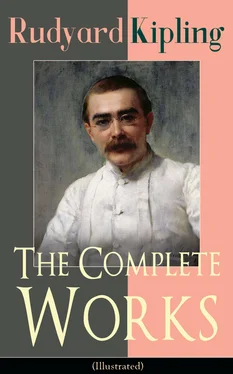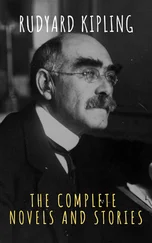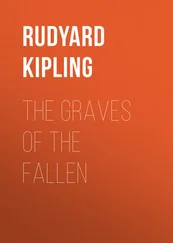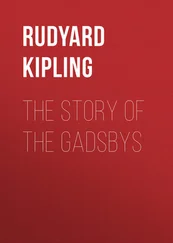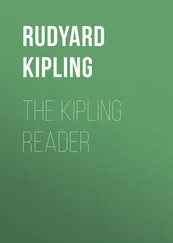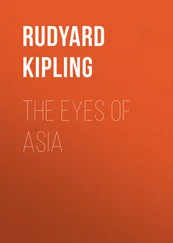From love by natural sequence to death. Where is the Park Street Cemetery? A hundred hack-drivers leap from their boxes and invade the market, and after a short struggle one of them uncarts his capture in a burial ground — a ghastly new place, close to a tramway. This is not what is wanted. The living dead are here — the people whose names are not yet altogether perished and whose tombstones are tended. ‘Where are the old dead?’ ‘Nobody goes there,’ says the driver. ‘It is up that road.’ He points up a long and utterly deserted thoroughfare, running between high walls. This is the place, and the entrance to it, with its gardener waiting with one brown, battered rose for the visitor, its grilled door and its professional notices, bears a hideous likeness to the entrance of Simla churchyard. But, once inside, the sightseer stands in the heart of utter desolation — all the more forlorn for being swept up. Lower Park Street cuts a great graveyard in two. The guide-books will tell you when the place was opened and when it was closed. The eye is ready to swear that it is as old as Herculaneum and Pompeii. The tombs are small houses. It is as though we walked down the streets of a town, so tall are they and so closely do they stand — a town shrivelled by fire, and scarred by frost and siege. Men must have been afraid of their friends rising up before the due time that they weighted them with such cruel mounds of masonry. Strong man, weak woman, or somebody’s ‘infant son aged fifteen months,’ for each the squat obelisk, the defaced classic temple, the cellaret of chunam, or the candlestick of brickwork — the heavy slab, the rust-eaten railings, whopper jawed cherubs, and the apoplectic angels. Men were rich in those days and could afford to put a hundred cubic feet of masonry into the grave of even so humble a person as ‘Jno. Clements, Captain of the Country Service, 1820.’ When the ‘dearly beloved’ had held rank answering to that of Commissioner, the efforts are still more sumptuous and the verse . . . Well, the following speaks for itself:—
Soft on thy tomb shall fond Remembrance shed
The warm yet unavailing tear,
And purple flowers that deck the honoured dead
Shall strew the loved and honoured bier.
Failure to comply with the contract does not, let us hope, entail forfeiture of the earnest-money; or the honoured dead might be grieved. The slab is out of his tomb, and leans foolishly against it; the railings are rotted, and there are no more, lasting ornaments than blisters and stains, which are the work of the weather, and not the result of the ‘warm yet unavailing tear.’
Let us go about and moralise cheaply on the tombstones, trailing the robe of pious reflection up and down the pathways of the grave. Here is a big and stately tomb sacred to ‘Lucia,’ who died in 1776 A.D., aged 23. Here also be lichened verses which an irreverent thumb can bring to light. Thus they wrote, when their hearts were heavy in them, one hundred and sixteen years ago:—
What needs the emblem, what the plaintive strain,
What all the arts that sculpture e’er expressed,
To tell the treasure that these walls contain?
Let those declare it most who knew her best.
The tender pity she would oft display
Shall be with interest at her shrine returned,
Connubial love, connubial tears repay,
And Lucia loved shall still be Lucia mourned.
Though closed the lips, though stopped the tuneful breath,
The silent, clay-cold monitress shall teach —
In all the alarming eloquence of death
With double pathos to the heart shall preach.
Shall teach the virtuous maid, the faithful wife,
If young and fair, that young and fair was she,
Then close the useful lesson of her life,
And tell them what she is, they soon must be.
That goes well, even after all these years, does it not? and seems to bring Lucia very near, in spite of what the later generation is pleased to call the stiltedness of the old-time verse.
Who will declare the merits of Lucia — dead in her spring before there was even a Hickey’s Gazette to chronicle the amusements of Calcutta, and publish, with scurrilous asterisks, the liaisons of heads of departments? What pot-bellied East Indiaman brought the ‘virtuous maid’ up the river, and did Lucia ‘make her bargain’ as the cant of those times went, on the first, second, or third day after her arrival? Or did she, with the others of the batch, give a spinsters’ ball as a last trial — following the custom of the country? No. She was a fair Kentish maiden, sent out, at a cost of five hundred pounds, English money, under the captain’s charge, to wed the man of her choice, and he knew Clive well, had had dealings with Omichand, and talked to men who had lived through the terrible night in the Black Hole. He was a rich man, Lucia’s battered tomb proves it, and he gave Lucia all that her heart could wish a green-painted boat to take the air in on the river of evenings, Coffree slave-boys who could play on the French horn, and even a very elegant, neat coach with a genteel rutlan roof ornamented with flowers very highly finished, ten best polished plate glasses, ornamented with a few elegant medallions enriched with mother-o’-pearl, that she might take her drive on the course as befitted a factor’s wife. All these things he gave her. And when the convoys came up the river, and the guns thundered, and the servants of the Honourable the East India Company drank to the king’s health, be sure that Lucia before all the other ladies in the Fort had her choice of the new stuffs from England and was cordially hated in consequence. Tilly Kettle painted her picture a little before she died, and the hot-blooded young writers did duel with smallswords in the Fort ditch for the honour of piloting her through a minuet at the Calcutta theatre or the Punch House. But Warren Hastings danced with her instead, and the writers were confounded — every man of them. She was a toast far up the river. And she walked in the evening on the bastions of Fort William, and said, ‘La! I protest!’ It was there that she exchanged congratulations with all her friends on the 20th of October, when those who were alive gathered together to felicitate themselves on having come. through another hot season; and the men — even the sober factor saw no wrong here — got most royally and Britishly drunk on Madeira that had twice rounded the Cape. But Lucia fell sick, and the doctor — he who went home after seven years with five lakhs and a half, and a corner of this vast graveyard to his account — said that it was a pukka or putrid fever, and the system required strengthening. So they fed Lucia on hot curries, and mulled wine worked up with spirits and fortified with spices, for nearly a week; at the end of which time she closed her eyes on the weary river and the Fort for ever, and a gallant, with a turn for belles-lettres , wept openly as men did then and had no shame of it, and composed the verses above set, and thought himself a neat hand at the pen — stap his vitals! But the factor was so grieved that he could write nothing at all — could only spend his money — and he counted his wealth by lakhs — on a sumptuous grave. A little later on he took comfort, and when the next batch came out —
But this has nothing whatever to do with the story of Lucia, the ‘virtuous maid, the faithful wife.’ Her ghost went to a big Calcutta powder ball that very night, and looked very beautiful. I met her.
Plain Tales From the Hills
Table of Contents
Lispeth
Three And—an Extra
Thrown Away
Miss Youghal's Sais
Yoked With an Unbeliever
False Dawn
The Rescue of Pluffles
Cupid's Arrows
His Chance in Life
Читать дальше
